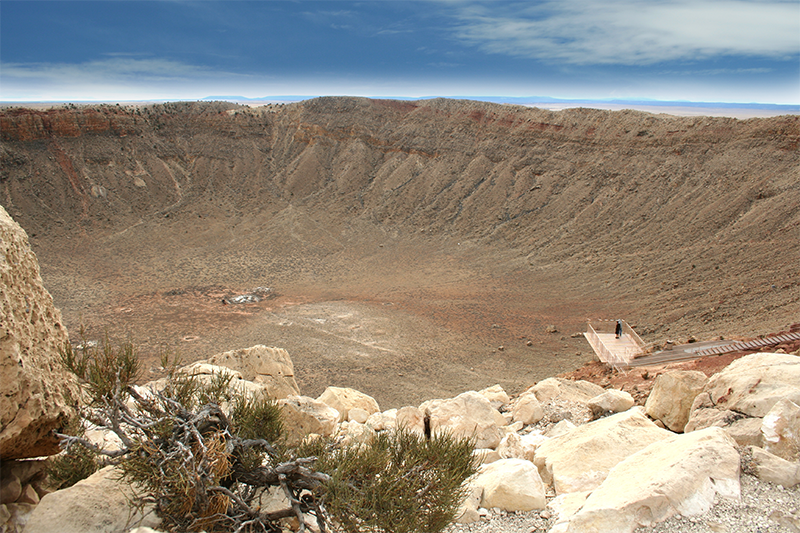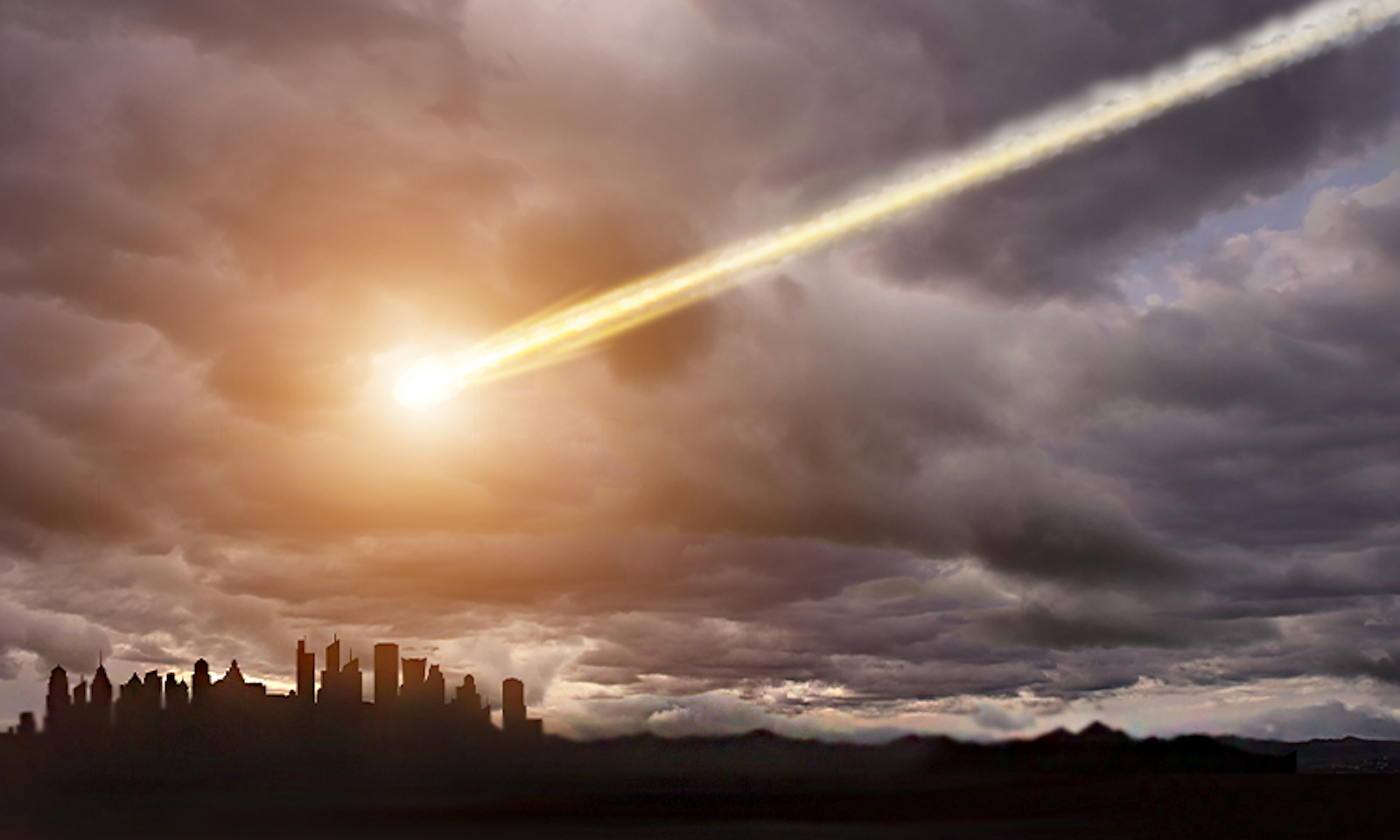Humanity lives on the edge of disaster. The celestial sphere, suspended and serene above us, has guided our species for millennia, serving as a source of stories, wonder, and navigation. But the sky is also full of threats. Asteroids, comets, and meteoroids, traveling at tens of thousands of miles per hour, completely silent and nearly invisible, crisscross the solar system and the orbit of the Earth. When the smallest ones, no bigger than a grain of sand, enter our atmosphere, we watch in delight as a shooting star flies across the heavens.
But when the larger objects strike, they unleash not marvels, but death and destruction. When an asteroid several miles wide struck off the northern coast of the Yucatan peninsula in the Gulf of Mexico 66 million years ago, the resulting impact rattled the Earth to its very iron core, uplifted crustal material and sent it raining hellfire across the globe, plunged our planet into a suffocating “impact winter,” and permanently ended the lineages of all non-avian dinosaurs.
The rate of an asteroid larger than 3 miles across striking the Earth is approximately once every 6 million years.
More recently, some 50,000 years ago, a meteorite about 160 feet across (less than half the length of a football field) struck Earth with a velocity of 29,000 miles per hour. The energy released in the collision was equivalent to 600 Hiroshima bombs. Among other cataclysmic effects, the impact could be felt in the form of a 1,000-mph wind blast more than two miles from the site. The crater today, just east of Flagstaff, Arizona, is roughly 560 feet deep and three quarters of a mile across.
With just a few thousand feet of orbital misfortune, we could lose a population center at a level unheard of even after the advent of nuclear weapons. We could see the collapse of not just one, but all human civilization, and possibly the extinction of our species—or even all the species on the planet. In short, it would be really, really bad.
A substantial collision is bound to happen again. We don’t know where or when. But it will happen. Are we ready? No. Not in the slightest. But for the first time in the planet’s history, we have arrived at a point in time where we could do something to alter its astronomical fate.
The question is whether we will. Yes, we are capable of long-term planning. Medieval Europeans spent centuries building their great cathedrals. Ancient Chinese empires spent generations expanding irrigation networks, many of which are still used today. For tens of thousands of years nations of all stripes have spent decades and untold resources—and the blood of their populace—in evolving combat against their enemies. But these projects have had a tangible, immediate, and familiar feel to them. The threat posed by asteroids and comets is a whole other story. (We also aren’t doing so well with nebulous threats of climate change and zoonotic diseases.)

Part of the reason is that asteroids and comets don’t appear to be a problem right now. Yes, there is the occasional amusing news story of a stray meteorite burrowing itself into someone’s car or home. But impacts have not presented much immediate danger. In fact in the entire span of recorded human history, as astronomers have been watching the skies like sentries on Castle Black, no asteroid or comet has ever appeared as a threat to any society, culture, or civilization. In 2019, researchers reported the rate of an asteroid larger than 3 miles across striking the Earth (and wiping out humanity) is approximately once every 6 million years.
But on geological and astronomical timescales, humans are newborns. If we are to last as a species, even into middle age, we are likely to encounter a major threat bearing down on us from the heavens. To prepare ourselves, somebody better start planning right now, today. Despite our vigilant astronomers, you might be surprised to know that no one nation or organization is responsible for protecting our planet.
It’s not that nations aren’t giving the end of the world some thought. In 2005, the United States congress mandated that NASA develop the capabilities to identify, track, and characterize all near-Earth objects (NEOs) larger than about 460 feet across by 2020. A rock this size could easily wipe out any of our largest cities, trigger earthquakes and tsunamis, and worse. And as a case study into the paradoxes of dealing with these kinds of improbable-but-existential risks, that mandate did not come with any funding. As of today, we have yet to identify even a third of all estimated threatening objects.
There is no technology, survey, or program in operation today to monitor all the potential threats to Earth.
But some groups, notably NASA’s Planetary Defense Coordination Office and the International Astronomical Union’s Minor Planet Center, have taken up the mantle of protecting humanity from cosmic disaster. They operate in the shadows of larger projects, eking by on the scraps of their funding.
The first step for would-be planet-savers is identification. The trouble is, not only are these cosmic objects relatively small and dim, but their movements are constantly in flux. Identifying and tracking a small asteroid for a few days or weeks is enough to reasonably predict its path for the next few decades. But after that, small gravitational interactions with its neighbors (or even the motions of the giant planets) and unequal heating from the sun can send it into a wildly different—and possibly dangerous—orbit. There is no technology, survey, or program in operation today or even on the horizon to continuously and comprehensively monitor all the potential threats to Earth.
And to have the best chances at saving ourselves, the object would need to be spotted years before a potential impact. Even then, it’s not exactly clear what we would do about it.
A preemptive impact with the object in space is one possibility. NASA’s proof-of-concept DART mission made headlines last year when it slammed head-first into Dimorphos, an asteroid 560 feet wide. The tiny cubelike spacecraft, measuring little more than 4 feet on each side, only packed a mass of about 1,260 pounds. And initial observations (a more complete assessment awaits the follow-up HERA mission to be launched by the European Space Agency in late 2024) suggest that the mission was a success, nudging the asteroid (which wasn’t an immediate threat) into a slightly different trajectory.
This worked because, in space, small changes have big impacts. If we spot a threat early enough, we could conceivably launch a spacecraft to alter its trajectory—even if just slightly. As the asteroid continued in its shifted path in the intervening years, however, that small change would add up, resulting in a complete miss of Earth. We hope.
But one of the problems is that not all asteroids are monoliths like Dimorphos (or as small). Many, especially the larger ones, are actually complex agglomerations of loose rubble. The DART mission worked on Dimorphos, but a similar approach may not work on a different asteroid with a different character.
Nuclear weapons are an obvious alternative, but difficult to test—no country is in the mood to raise international ire for lobbing nuclear bombs into space. So groups like the B612 Foundation (spun-up on private funding, including from internet pioneer Vint Cerf and the indie rock group Broken Bells) have had to make do with theoretical calculations and computer simulations as to how an atomic blast could nudge an object off its course. These simulations are a rather rough sketch. We lack the sophistication to know if anything in our extant arsenal could seriously knock an asteroid, or exactly how to deploy such a mission.
Another possibility is to implant a nuclear warhead deep within the asteroid (yes, Armageddon was based on legitimate research), hoping to disassociate the loose rubble pile into chunks so small they wouldn’t survive passage through our atmosphere … or turn a single large threat to one area into multiple disasters across the globe. It’s tough to say exactly what would happen.
Less explosive proposals hope to use forces of nature against an unruly asteroid. It might be possible to set up a gravity tractor, which is, unfortunately for sci-fi aficionados, not a tractor beam. Instead it’s merely a spacecraft in orbit around the asteroid that gently changes its own direction and uses its miniscule but persistent gravitational pull to steer the asteroid. Or we could coat a large portion of the surface of the asteroid in reflective material, changing the proportion of sunlight being absorbed by the asteroid. Since light has momentum, this too would act to change the asteroid’s course slightly over time, and hopefully enough to miss Earth.
All of these methods are, at least on paper, feasible. But besides DART we have not yet tested any of them, and so we do not know how effective and controllable they might be. We also don’t know how much time and money would be needed to bring any of them out of modeling and into deployable status. The disparate groups around the globe, pulling on meager threads of funding and time, are trying to go against the tide of human inclination by preparing for a threat that likely will not manifest itself in our lifetime, or our children’s lifetimes, or perhaps for dozens of generations to come. But if they are successful, some day, our far future descendants will thank them and their lucky stars that someone decided to plan for the long-shot worst. ![]()
Paul M. Sutter is a research professor in astrophysics at the Institute for Advanced Computational Science at Stony Brook University and a guest researcher at the Flatiron Institute in New York City. He is the author of Your Place in the Universe: Understanding our Big, Messy Existence.
Lead image: sdecoret / Shutterstock




























